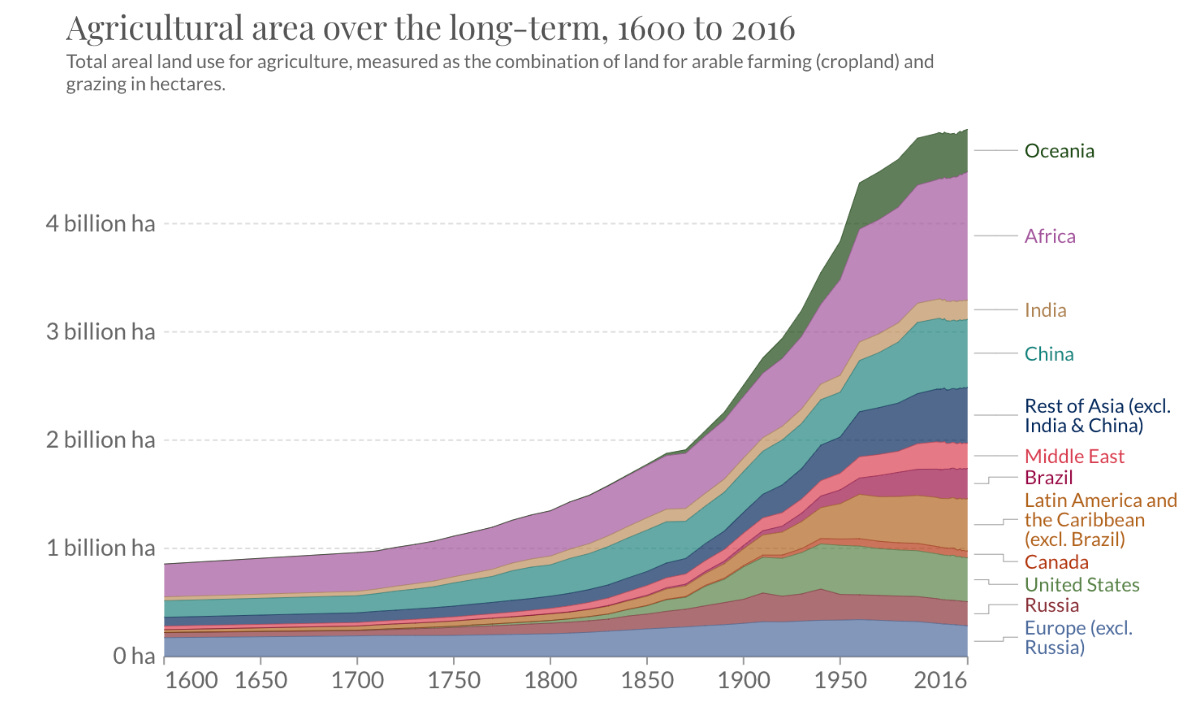#28 Regenerative Agriculture
The key to fixing climate change through agriculture
Read time: 5 minutes
In this week’s issue you will learn about the right techniques to use when farming and the huge impact they have on climate change: Regenerative Agriculture
“The Earth’s soil contains more than 3 times the amount of CO2 in the atmosphere. To reach net zero, we need soil to absorb even more of it.“ - Al Gore
Top Regenerative Agriculture News 🗞️
Awards: In Fast Company’s 2023 Most Innovative Companies in the World list, Regrow has been named #1 in Agriculture and #41 overall.
PepsiCo’s bet: The company is planning to invest $216 million in regenerative agriculture projects across the US to get closer to its net zero goals.
Luxury brands joining: Kering and L’Occitane Group launch a €300 million fund to invest in nature conservation and restoration initiatives and to help farmers transition to regenerative agriculture.
Let’s dive in 🧠
Close to 19% of global CO2 emissions come from agriculture and 38% of the world’s land is classified as “agricultural area” by the FAO.
Besides cow farts and energy use, the biggest issue when it comes to agriculture and emissions is the way in which we are treating our land to produce the food we, and the animals we eat, eat.
The best example of this is the “Dust Bowl”, a 1930s phenomenon that blew much of the Texas, Oklahoma and Kansas region topsoil away with the wind. This happened because the really bad farming techniques depleted the plains.
So what’s wrong with traditional industrial farming?
Plows tear apart the soil’s connective tissue, disrupting the natural ecosystem and pouring CO2 into the air.
We then use fertilizers, pesticides and herbicides to try to get more productivity out of the depleted land. This pollutes the land and the water streams even more and causes the release of nitrous oxide into the air (a gas 300 times worse for climate change than CO2).
And why is soil so important?
Soil is created over time, as carbon-rich plants and animal residues are broken down by bacteria. The organic matter that’s left is a perfect storage for carbon and also nutrients for plants.
Healthy soil contains many pores, plant roots, worms and fungi. These micro-tunnels allow roots to grow into the soil and help the soil retain more water and become more resistant to droughts.
Remember, the darker and the richer the soil, the better!
Sure, but what is regenerative agriculture?
It’s a set of centuries-old farming and grazing practices that enhance the soil’s ability to retain carbon.
These are the 6 main methods:
Minimising chemical inputs: They destroy biodiversity and pollute waterways.
Minimising tilling systems: Tilling exposes buried organic matter to oxygen, which releases CO2 into the air.
Incorporating livestock: This combines animals and plants in a circular ecosystem.
Increasing biodiversity: To boost nutrients, natural decomposition and attract insect predators of pests.
Rotating crops: To naturally balance what is being taken out and put into the soil.
Cover crops: To maintain the soil as carbon rich and humid as possible.
And the main advantages:
Produce and quality: Because of the very rich soil, the land becomes way more resilient and can last for many more years yielding high quality produce.
Yield: This really depends o the specific crop and the local conditions. In the long-term yield tends to stay the same or even increase whereas in industrial farming it decreases quickly or becomes more costly to maintain.
Climate change: Instead of being a huge carbon releaser, land used for agriculture can become a massive carbon sink when using the right techniques.
Other revenue streams: By using regenerative agriculture techniques, farmers can potentially start selling carbon credits which others can use to offset their emissions.
Regenerative agriculture has the potential to help us restore biodiversity and avoid emitting billions of tonnes of CO2. Individual farmers and large companies worldwide are already starting to invest in it but why isn’t it everywhere?
Challenges
Yield: These techniques can potentially lead to lower yields. It depends a lot on the type of crop and the local conditions.
Farmers’ knowledge: Many farmers will need to acquire new knowledge and skills to change their industrial farming mindset.
Cost: Near-term costs can exceed the farmer’s budgets even if in the long-term the profits exceed the costs. Governments must provide incentives to farmers to switch to regenerative agriculture.
Top Regenerative Agriculture Startups 💰
Luckily there are many more but this is just a small varied sample.
Nori 🇺🇸: This Web3 project has created a marketplace for tokenized regenerative agriculture carbon credits with full transparency thanks to blockchain. Buyers can see all the details about the carbon removed from the credits they buy.
Klim 🇩🇪: They help…farmers get compensated for using renewables and environmental protection measures, companies who want to get carbon credits for supporting regenerative farmers in their region, and companies with agricultural supply chains to measure and account for Scope 3 emissions.
Regrow 🇺🇸: They have several products and platforms that together help provide an end-to-end solution for regenerative agriculture. Crop insights, sustainability insights, MRV (measure, report, verify) platform, etc.
Agreena 🇩🇰: Their “AgreenaCarbon“ soil carbon marketplace allows farmers to earn extra income from producing carbon credits by doing regenerative agriculture. They use both ground and satellite data to make their MRV process as reliable as possible.
Large companies are starting to partner with these startups since they see many benefits: Extra revenue from carbon credits, improved brand reputation, better and healthier produce, etc.
❗Extreme knowledge area❗
Just in case that wasn’t enough…
Kiss the Ground (Netflix): This excellent 2020 documentary brings together scientists and celebrities to explore and prove the importance of the Earth’s soil in combating climate change.
EU Soil Health Dashboard: A new EU tool to monitor the state of soil health across Europe.
Regenerative Farm Map: Use your zip code to discover regenerative farms near you so you can buy from them. Works all around the world!
That’s it for today, 1 climate tech topic in under 5 minutes.
Next week… Water distribution! 🤯
If you enjoyed today’s issue, the best compliment you could pay me would be to share it with one person who you think would benefit from it :)











